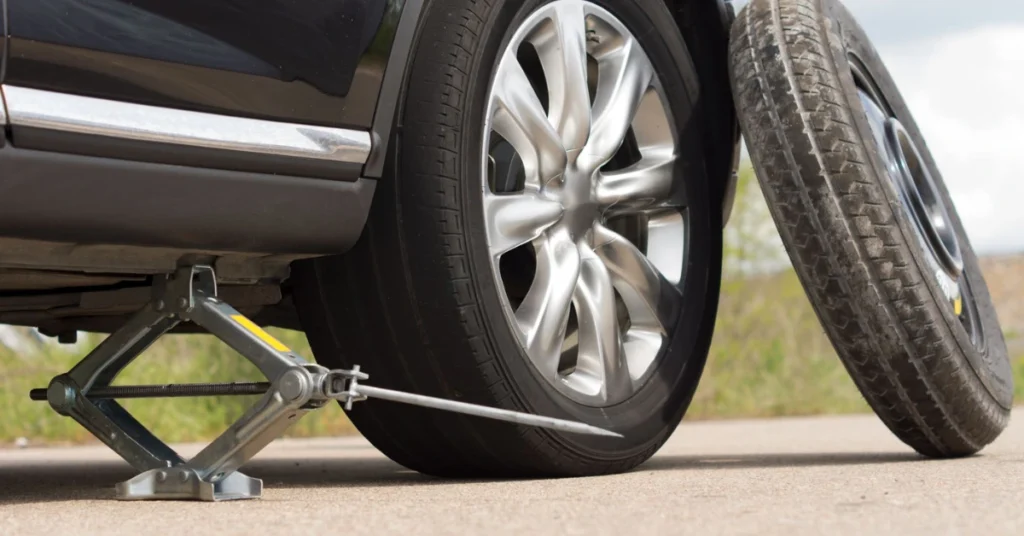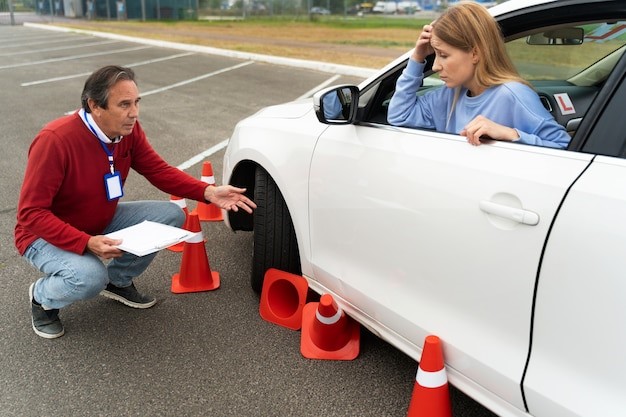Flat tires can happen to you at the most unexpected moments. Whether you’re trying to drive on a busy highway or just visiting your surroundings, it is essential to know what to do when you have a flat tire so that you handle it safely and get back on the road as quickly as possible. If the situation is critical enough, it can help prevent some unsafe conditions. In this guide, we’ll show you what to do when you get a flat tire, how to spot the problem, and how to perform a roadside tire swap.
Causes of Flat Tire
A flat tire is a tire that has experienced the de- consent of the air pressure present in it so that it is no longer able to support the weight of the vehicle. This can happen because of many reasons, and other times at inconsiderable times and is not only uncomfortable but also dangerous. Being aware of the most expected ones that cause a flat tire can help you avoid them, and stay safer on the road.
Common Causes:
- Puncture by sharp objects: Puncture with sharp things: Nails, screws, or pieces of broken glass can go through the tire and lead to the escape of air.
- Valve stem issues: A corroded valve stem or damages may lead to air leakage over a long period of time.
- Worn-out tires: Tires that are worn out or bald are easily prone to break and blow-out.
- Impact damage: A hit against a pothole, curb and road debris can result in the rupture of a tire.
- Over or under-inflation: Inaccurate inflation pressure poses a strain to the tire and exposes it to failure.
- Rim damage: Bent or even cracked rims may create a seal in the tire loose, resulting in a loss of air.
- Vandalism or theft: Willful deflation or interference with the tire may also cause the tire to go flat.
The Flat Tire Emergency Steps: Act Fast
When you’re driving and realize your car has a flat tire, try to remain calm and focus on these steps. Here’s what you need to do:
1. Pull Over to a Safe Area
The priority is getting your vehicle off the road. Find a safe place to stop off the road – parking lots, road shoulders, or any brightly lit areas will work. Avoid pulling over in heavy traffic or where you may block traffic, or where a secondary crash may be a concern.
Pro tip: If you are on a highway, pull off the road, turn on your hazard lights, and set up warning triangles to warn other drivers.
2. Confirm the Flat Tire
Once you’ve parked in a safe location, visually inspect your tire to make sure it really is flat. Search to see if there’s any puncture or damage to the tire you were facing.
3. Gather Necessary Tools
Tools you need when you have to change out the tire yourself:
- A car jack
- A lug wrench
- A spare tire
- Wheel chock (not required, but recommended for safety)
- Tire pressure gauge (to check after the repairs)
Before you even think about making any repairs, ensure that you have all these tools in your car.
How to Change a Flat Tire: Step-by-Step

Replacing a flat tire may feel daunting, but with the proper tools and instructions, it’s a simple task. Here’s a step-by-step breakdown:
1. Loosen the Lug Nuts
Spin the lug nuts anti-clockwise on the flat tyre at ground level with a lug wrench. Do not remove them completely—just loosen by twisting counter-clockwise.
2. Jack Up the Car
Position the jack (car jack) under the car’s jacking point (usually located just behind the tire you need to change. Jack up the car until the flat tire is completely off the ground.
Pro tip: Always follow the manufacturer’s instructions regarding the correct placement of the jack — to avoid damage your car.
3. Remove the Flat Tire
If the car has been raised, unscrew all the loose lug nuts completely, then take the flat tire off the car. Set it aside.
4. Install the Spare Tire
Align the holes with the bolts and place the spare wheel on the wheel hub. When the tire is in place, hand-tighten the lug nuts onto the wheel bolts.
5. Lower the Car and Tighten the Lug Nuts
Lower the car back down gently (if necessary) with the jack, and tighten the lug nuts as tightly as possible in a star pattern. This ensures an even fit against the tire.
6. Check Tire Pressure After Repair
When you get your spare tire on, check the tire pressure and ensure it’s inflated properly. Verify that it meets the manufacturer’s specifications by checking it with a tire pressure gauge.
Preventing Future Flat Tires: Tips and Tricks

In some cases, it might not be safe or practical to change the tire yourself, especially if you’re in an unknown area or don’t have the proper tools. This is when to consider calling for roadside assistance.
Key Fob Spare and Magnetic Key Holders
To avoid finding yourself without a spare tyre or a puncture repair kit, keep a spare puncture in the boot, or invest in a magnetic key holder you can stick to your car for emergency access.
Smart Tire Monitors
Modern technology also brings us tire pressure monitoring systems (TPMS) that alert you when your tire pressure is low, which also reduces the risk of blowouts due to low tire pressure.
Lack of Tools or Experience
If you don’t have the proper tools or don’t want to risk changing your tire, it’s a good idea to call in the professionals. In the worst case, a roadside service will arrive with the tools and skills you need to know to handle the situation.
Avoid Dangerous Location
If you’re stranded in a high-traffic area or on a dangerous road, professional roadside assistance is usually the best option. They have the expertise and tools to manage the situation safely.
When You Need Roadside Assistance
Flat tires are a common road emergency, but there are circumstances when booking professional assistance is a safer and easier solution. If you don’t have the tools, don’t know how to handle, or are in a dangerous situation, it’s time to call for help and get towed to a service station. Here are cases in which you’re encouraged to seek out professional assistance.
- Lack of Proper Tools or Experience: In the case that you don’t have the right tools or know how to change a tire, roadside assistance takes care of that safely with a professional.
- Dangerous Location: Whether you’re on a busy highway or in a dangerous neighborhood, always think safety first and then handle the situation.
- Severe Weather Conditions: It’s unsafe to change a tire in the rain or snow. A roadside service can make it both quick and safe.
- Inaccessible Area: If you’re off the beaten track or in a hard-to-reach area, it’s often simpler for a roadside service to assist you.
Conclusion
Getting a flat tire is an unavoidable part of owning a vehicle, while getting locked out of a vehicle and knowing how to handle the situation can save you time, money, and a headache. Whether you opt to fix the tire yourself or you need to call for roadside assistance, it’s always a good idea to be prepared and have the right tools to work with a flat tire safely. But maintaining and even preparing your tires according to a schedule can also reduce unpredictability, making your driving safer.
FAQs
Remove your tire if there are visible flat spots, punctures, or any damage to the tire sidewall. Additionally, you may need to replace it if the pressure is too low and doesn’t hold air after a repair.
It’s not safe to drive on a flat tire. You’re risking damage to the tire, wheel, and your vehicle. If you have a flat tire, you can’t put it off — otherwise, you risk more expensive repairs down the road.
The cost for flat tire roadside assistance can differ from provider to provider. You’ll typically pay $50 to $100 for flat tire service through a roadside assistance provider. Without a roadside assistance plan, a professional tire change service can cost more.
Check air pressure regularly, frequently inspect tires for damage, and avoid driving over rough or debris-filled roads. Buying quality tires and maintaining regular rotations of those tires can also minimize your chances of a flat.




